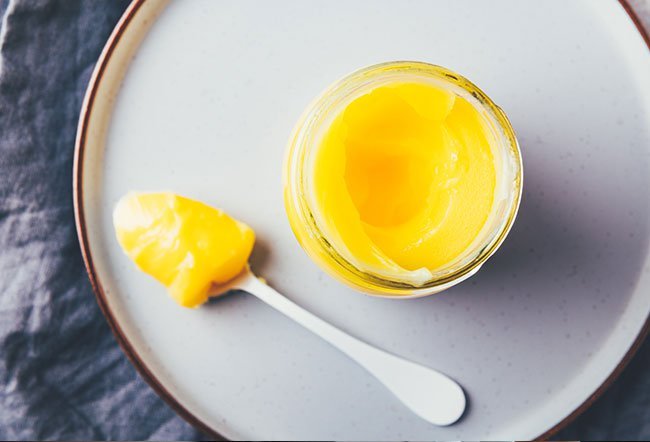What Is the Difference Between Butter and Ghee?

The difference between butter and ghee is listed below.
| Difference | Ghee | Butter |
|---|---|---|
| Burning point | Higher (485°F) | Lower (350°F) |
| Lactose-free | Yes | No |
| Fat concentration | Slightly higher | Slightly lower |
| Dairy proteins | Slightly lower | Slightly higher |
| Nutrients |
Vitamin A Vitamin C Vitamin D Vitamin K Vitamin E |
Vitamin A Vitamin D Vitamin E Calcium |
What is ghee?
Ghee is clarified butter commonly used in Indian and Pakistani cuisines. It is made from butter obtained from cow or buffalo milk. Cow milk butter is heated on low heat until water evaporates, leaving behind milk solids. The solids are skimmed or strained if needed. The remnant is clarified liquid fat known as ghee.
Ghee has a higher burning point, making it favorable for frying and sautéing. Unlike butter, ghee retains most of the nutrients because it is treated with low heat (usually less than 100°).
100 grams of ghee consists of the following. (See the below chart)
| Name | Amount | Unit |
|---|---|---|
| Water | 0.24 | gram |
| Energy | 876 | Kcal |
| Total lipid (fat) | 99.48 | gram |
| Protein | 0.28 | gram |
| Calcium, Ca | 4 | Mg |
| Phosphorus, P | 3 | Mg |
| Potassium, K | 5 | Mg |
| Sodium, Na | 2 | Mg |
| Zinc, Zn | 0.01 | Mg |
| Copper, Cu | 0.001 | Mg |
| Thiamin | 0.001 | Mg |
| Riboflavin | 0.005 | Mg |
| Niacin | 0.003 | Mg |
| Vitamin B6 | 0.001 | Mg |
| Choline, total | 22.3 | Mg |
| Vitamin B12 | 0.01 | µg |
| Vitamin A, RAE | 840 | µg |
| Retinol | 824 | µg |
| Carotene, beta | 193 | µg |
| Vitamin E (alpha-tocopherol) | 2.8 | Mg |
| Vitamin K (phylloquinone) | 8.6 | µg |
| Fatty acids, total saturated | 61.924 | gram |
| Fatty acids, total monounsaturated | 28.732 | gram |
|
Fatty acids, total polyunsaturated |
3.694 | gram |
| Cholesterol | 256 | Mg |
What is butter?
Butter is a dairy product made from proteins and fats found in milk and cream. Butter is made at home by churning milk or cream to separate fat globules from the buttermilk. Sometimes, salt and food colors may also be added to butter. One tablespoon of unsalted butter consists of the following.
| Name | Amount | Unit | Percent DV |
|---|---|---|---|
| Energy | 100 | kcal | |
| Protein | 0 | gram | |
| Total lipid (fat) | 11 | gram | 17 |
| Carbohydrate, by the difference | 0 | gram | |
| Sodium, Na | 1.96 | Mg | |
| Vitamin A, IU | 400 | IU | 8 |
| Fatty acids, total saturated | 7 | gram | 36 |
| Fatty acids, total trans | 0 | gram | |
| Cholesterol | 30 | mg | 10 |
What are the health benefits of ghee?
According to research, ghee has innumerable benefits because of the way it is cooked. Some of the benefits of ghee when consumed in moderation include
- Used as an emollient for chapped lips and skin
- Soothes inflammation within the body (gastric ulcers)
- May help reduce excess weight gain (by inducing satiety)
- Protects the heart and can help reduce unhealthy cholesterol levels if taken in minimal amounts
- Beneficial for lactose-intolerant people
- Aids healthy digestion
- Used as a solvent for many ayurvedic medications (Indian alternative medication) used in the treatment of diseases
What are the health benefits of butter?
Butter, if consumed in moderation, can be a healthy part of a person’s diet because of the presence of calcium and compounds that combat obesity. Some of the benefits of butter when consumed in moderation include
- Reduces the risk of cancer (because of the presence of beta-carotene in butter)
- Slows the rate of vision loss or age-related macular degeneration
- Strengthens the bones
- Makes the skin healthier
What are the potential risks of ghee and butter?
Butter and ghee, if consumed in moderation, are healthy. However, if consumed in excess, they can lead to weight gain and obesity. Both ghee and butter should be consumed with caution by people with heart diseases.
